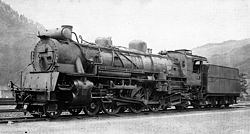An engine was imported, and the tender was made in a Japanese factory. Six engines represented a very low number and was not good business from ALCO's standpoint. ALCO expected more orders, but, only six engines were made. C52 not only had three-cylinders, but other new technology as well. These were helpful in regard to future domestic product engine design.
After their appearance, they went into service on the Tokaido main line as express trains. C52s increased their pulling capacity by 20% from the domestic model C51. But the domestic three-cylinder model C53 later appeared, and since there were only six C52s, the importation of foreign parts represented problems. Another problem was, C52's driving wheel diameter of 1,600mm was not satisfactory for Japanese passenger trains or even freight trains.
Afterward, all the C52s were moved to Seno depot on the Sanyo line, for banking at Seno-Hachi Pass. And lastly, they were moved to yard work at Shimonoseki yard during WW2. C52s were not used after the war, and after Jun 25 1947, all C52s were scrapped.

Class C52 No.1
at Seno depot. During Aug.1938
(Photo credit to JNR Takatori Factory by K.N.)


